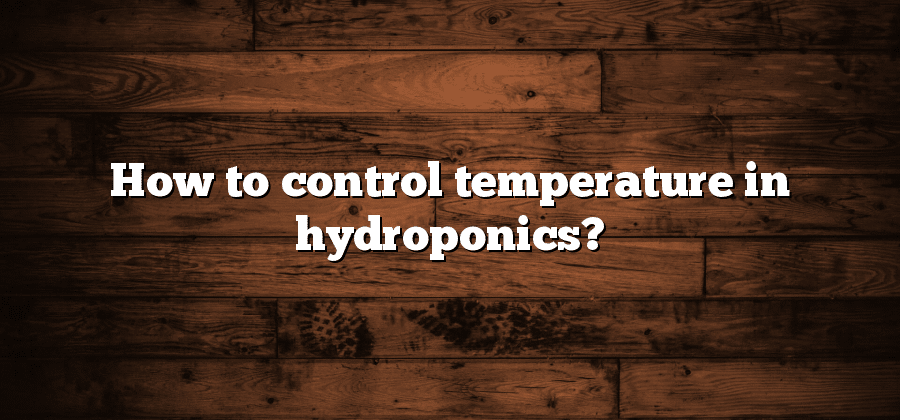Understanding the Impact of Temperature in Hydroponics
Temperature plays a crucial role in the success or failure of hydroponic systems. It can greatly impact the growth and development of plants, as well as the overall productivity of the system. In hydroponics, temperature regulates various physiological processes in plants, such as nutrient uptake, photosynthesis, and respiration.
Extreme temperatures, whether too high or too low, can result in detrimental effects on plant health and growth. High temperatures can lead to the wilting of plants, inhibited nutrient absorption, and reduced photosynthetic activity. On the other hand, excessively low temperatures can slow down a plant’s metabolism and hinder nutrient uptake. It is crucial for hydroponic farmers to understand the impact of temperature and implement measures to maintain optimal conditions for plant growth. By carefully monitoring and controlling the temperature within hydroponic systems, growers can ensure the health and productivity of their crops.
Optimal Temperature Range for Hydroponic Systems
Achieving and maintaining an optimal temperature range is crucial for the success of hydroponic systems. The temperature directly affects the growth and development of plants as it plays a significant role in their metabolic processes. While the specific temperature requirements may vary slightly depending on the plant species being cultivated, there is a general consensus about the ideal temperature range for hydroponics.
In general, the optimal temperature range for hydroponic systems falls between 65 to 75 degrees Fahrenheit (18 to 24 degrees Celsius). Within this range, plants can efficiently absorb nutrients, carry out photosynthesis, and undergo proper root development. When the temperature is too high, it can lead to excessive transpiration and oxygen deprivation in the root zone, negatively affecting plant health. On the other hand, temperatures that are too low can slow down growth and restrict nutrient uptake. Thus, maintaining the optimal temperature range is integral to ensure optimal plant growth and a high-yielding hydroponic system.
Importance of Monitoring Temperature in Hydroponics
Maintaining the optimal temperature range is crucial for the success of hydroponic systems. By closely monitoring and controlling temperature levels, growers can ensure that their plants are provided with the ideal conditions for growth and development.
Temperature plays a vital role in several key aspects of hydroponics, including nutrient uptake, plant metabolism, and overall plant health. Inadequate temperature control can lead to various issues such as nutrient deficiencies, stunted growth, decreased yield, and increased susceptibility to pests and diseases. Therefore, it is essential to regularly monitor the temperature within hydroponic systems to identify any potential deviations from the desired range and take prompt corrective measures. By doing so, growers can maximize their crop quality and yield, ultimately leading to greater profitability and sustainability in their hydroponic operations.
Evaluating the Effects of High Temperatures in Hydroponics
Hydroponics is a highly efficient method of growing plants without soil, making it an increasingly popular choice among modern farmers. However, like any agricultural system, hydroponics is not without its challenges. One of the key factors that can significantly impact the success of a hydroponic setup is temperature.
High temperatures in hydroponics can lead to a range of negative effects on plant health and productivity. Firstly, elevated temperatures can hinder the uptake of nutrients by the plants, affecting their overall growth and development. This can result in stunted growth, smaller yields, and even crop failure. Additionally, high temperatures can increase the risk of diseases and pest infestations, further compromising the health of the plants. Furthermore, extreme heat can also cause excessive water evaporation, leading to dehydration and wilting of the plants. All these factors highlight the importance of evaluating the effects of high temperatures in hydroponics and implementing strategies to mitigate their impact.
Strategies for Cooling Hydroponic Systems
One of the key challenges in hydroponic systems is maintaining the correct temperature for optimal plant growth. High temperatures can wreak havoc on plants, causing stunted growth and even death. Therefore, it is crucial to have effective strategies in place to cool the hydroponic systems and create an ideal growing environment.
One strategy is to provide adequate ventilation in the growing area. By allowing fresh air to circulate, the heat can be dissipated, preventing it from building up excessively. This can be achieved by using fans or installing ventilation systems that suck out hot air and bring in cooler air. Additionally, placing the hydroponic systems in a well-ventilated area or near windows can also help cool them down naturally.






